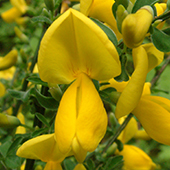
Invasive Plants
Invasive plants are those introduced from other regions and have the potential to negatively impact humans, animals and/or ecosystems.
We don’t consider all introduced plants invasive or harmful. Invasive plants can establish quickly and spread rapidly in new areas. You may also hear them called noxious weeds. Noxious weeds are harmful to animals or people. It is also a term to describe legally designated species within the B.C. Weed Control Act.
Please report any species of concern to us. We especially want to hear about those on the prevent or eradicate lists. See below.
Priority Invasive Plants in Saanich
We work with regional and provincial partners to track the status and priority of invasive plants in our region.
The Capital Region Invasive Species Partnership (CRISP) 
Saanich has a Noxious Weeds Bylaw. This requires landowners to control invasive plants and noxious weeds on private lands.
We have a Knotweed Stewardship Program which provides support and free treatment for Knotweed outbreaks on private property in Saanich due to the difficult nature of treating invasive Knotweeds and the high risk of impacts to our region. Combined with treatment on public land by Saanich Parks, knotweed has been reduced by nearly 70% since the program began in 2010!
How We Manage Invasive Plants
Saanich, CRISP and other provincial partners use four categories to manage invasive plants:
- Prevent
- Eradicate
- Contain
- Control
We include a few examples from our region’s priority plants in each category below. There are many other invasive plants.
View the CRISP List to see the full regional list of priority plants.
Eradicate List
“Early Detection Rapid Response” is an  important part of invasive management. We work to eliminate and control new invaders before they become wide-spread and have major impacts. The eradicate list identifies high priority new invasions or small enough populations that we can still eradicate them from an area or region.
important part of invasive management. We work to eliminate and control new invaders before they become wide-spread and have major impacts. The eradicate list identifies high priority new invasions or small enough populations that we can still eradicate them from an area or region.
Examples in Saanich:
- Knotweeds Fallopia spp (Alert Sheet)
- Garlic Mustard Alliaria petiolata (Alert Sheet)
- Giant Hogweed Heracleum mantegazzianum (Alert Sheet)
- Spotted Knapweed Centaurea maculosa
- Blessed Milk Thistle Silybum marianum (Alert Sheet)
- Policeman’s Helmet Impatiens glandulifera (Alert Sheet)
- Scotch Thistle Onopordum acanthium
- Shiny Geranium Geranium lucidum (Alert Sheet)
- Lesser Celandine Ranunculus ficaria (Alert Sheet)
Contain List
The contain list includes plants that are too established in some areas to eradicate, but are a priority to prevent spread to other areas. In Saanich these also include species of special concern like those with human or animal health impacts.
Examples in Saanich:
- Yellow Flag Iris Iris pseudacorus (Alert Sheet)
- Gorse Ulex europaeus (Alert Sheet)
- Poison Hemlock Conium maculatum (Alert Sheet)
- Purple Loosestrife Lythrum salicaria (Alert Sheet)
- Japanese Butterbur/Fuki Petasites japonicus (Alert Sheet)
- Italian Arum Arum italium (Alert Sheet)
- Golden Willow Salix alba var. vitellina
Control List
Most know about established invasive plants like English Ivy and Scotch Broom. These plants are still a concern, but we can’t eliminate them from our region. We focus our management of these species on:
- control in high value conservation areas.
- public education to avoid further spread.
Community volunteers with the Pulling Together Program help manage these control list species.
Examples in Saanich:
- Scotch Broom Cytisus scoparius
- English Ivy Hedera helix
- English Holly Ilex aquifolium
- Daphne / Spurge Laurel Daphne laureola
- Himalayan Blackberry Rubus armeniacus
- English Hawthorn Crataegus monogyna
- Periwinkle Vinca major, V. minor
While we have well-established invasive plants in Saanich, we need to keep them from spreading further. We also need to protect sensitive natural areas from them.
Property owners can help:
- Control invasive plants on your land.
- Properly dispose of garden waste and invasives.
To learn how to control some of our most established weeds, download our brochure:
To properly dispose of invasive plants, go to our Invasive Plant Disposal page.

